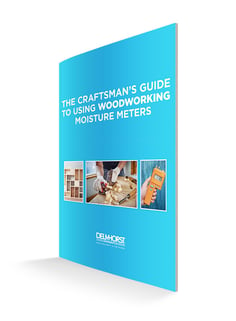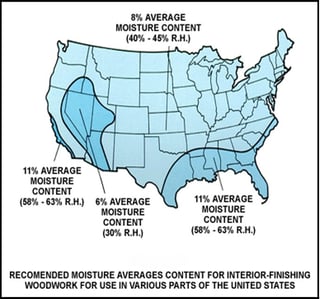 Equilibrium Moisture Content (or EMC for short) is a term that is closely linked to the woodworking industry. Simply put, equilibrium moisture content is the point where hygroscopic materials such as wood stop absorbing or dispersing moisture because they have reached a balance with their surroundings.
Equilibrium Moisture Content (or EMC for short) is a term that is closely linked to the woodworking industry. Simply put, equilibrium moisture content is the point where hygroscopic materials such as wood stop absorbing or dispersing moisture because they have reached a balance with their surroundings.
Craftsmen all over the country have to carefully monitor the moisture content of their wood products to make sure it is at its EMC value before finishing and shipping can occur.
Why is Equilibrium Moisture Content Important?
To anyone in the woodworking industry, knowing when a piece of wood will reach equilibrium with its surroundings is critical for preventing issues in a finished wood product.
For example, consider the effects of using a piece of wood that hasn’t been fully acclimated in furniture. If the wood had an average moisture content of 16% MC, but the EMC value of the environment is actually 8% MC based on ambient humidity, the wood will continue to shrink little by little over time as it approaches equilibrium with its surroundings.
In a severe case, this could cause the final product to warp or crack, ruining its appearance and compromising its structural integrity.
By verifying that wood is at the right moisture content to ensure equilibrium with its surroundings before using it to make a product, woodworkers can ensure stronger, higher-quality products.
How Woodworkers Can Verify EMC in Wood
Verifying that wood has reached equilibrium with the environment is a matter of patience. For products that will be sold locally, simply checking the %MC of wood a few times each day over the course of several days in your workshop environment should be enough. You’ll know that the wood has reached its EMC value when the %MC reading of the wood changes.
Note that it’s important to store wood in a regulated environment such as your workshop since ambient humidity conditions outside are prone to frequent change, which will alter the equilibrium moisture content of wood left outside.
The process for determining the right moisture content to ensure equilibrium for wood products sold to distant regions is a bit trickier, as relative humidity and temperature conditions can vary greatly.
 For example, many coastal regions of the U.S. tend to have a high relative humidity value (58-63% RH), while drier desert areas have a very low RH value (30% or less), with most other regions falling somewhere between the two extremes.
For example, many coastal regions of the U.S. tend to have a high relative humidity value (58-63% RH), while drier desert areas have a very low RH value (30% or less), with most other regions falling somewhere between the two extremes.
Wood products used in areas with RH values will need to be acclimated to have a higher %MC than wood products meant for use in drier areas. For example, wood products made for regions with high humidity between 58-63% RH will probably reach equilibrium at or near 11% MC, while wood in dry areas with 30% or less RH will reach equilibrium nearer 6% MC.
So, when making wood products for distribution to different areas of the country, maintaining climate-controlled conditions in your workshop that are close to the conditions of where you’ll be sending your products can help ensure the best results.
To check the relative humidity conditions in your workshop and storage areas, you’ll need a thermo-hygrometer. These devices can monitor both temperature and humidity to give you an accurate measure of the RH conditions of your work areas so you can adjust your climate control to better match the conditions of the region your products will be shipped to.
Having detailed information on both the %MC of wood and on the relative humidity helps woodworkers maximize the quality of their work.
Discover more about how you can increase quality to make woodwork you can be proud of by using specialized moisture measurement tools today!

Comments